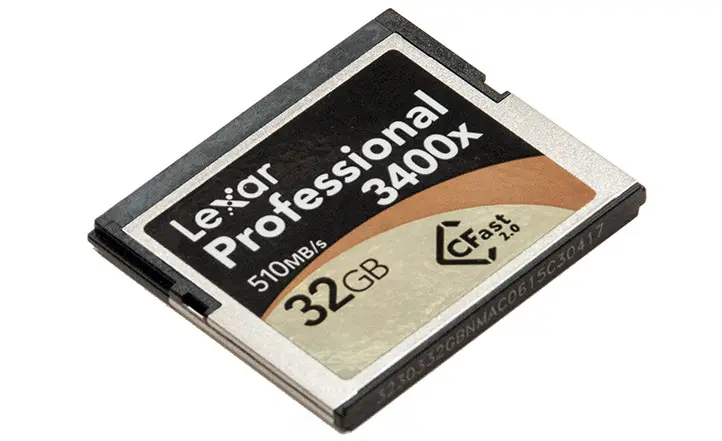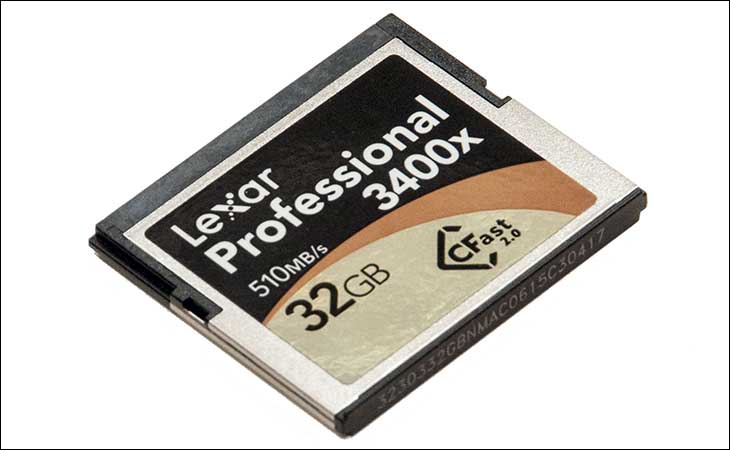The shipping container – and inner protective sleeve – is a dead ringer for the Lexar 1066X series. That is to say both are elegant, classy, and yet can be easy to confuse with one another. Thankfully the Lexar 3400X does state that it is a CFAST card and CompactFlash card so purchasing the wrong series would be pretty darn difficult.
On the positive side the back of the case not only goes over the usual details but also states what the cards performance rating is in MB/s. More importantly it lists both the read and write performance specifications. In the 3400X case that is 270Mb/s write and 510MB/s read. Needless to say this rating is much…much greater than what any CompactFlash card will ever hope of boasting.
As you can see the Lexar 3400X Professional CFast 2.0 series – and yes that is a mouthful – looks almost identical to the Lexar 1066X Professional CompactFlash series. Both use the CompactFlash/CFAST type 1 form-factor of 43mm X 36mm X 3.3mm, and both use the same color scheme for its label. We really do not have much problems with that, and will go over our reasoning in a moment, but you should pay attention as trying to insert a CFAST 2.0 card into a CompactFlash compatible camera will result in damaged pins inside the camera…which is a very expensive ‘oops’. Thankfully the keying on the side of CFast 2.0 cards is completely different than CompactFlash cards… so it would take a lot of effort to force one into a CompactFlash enabled camera – or vice versa, but we know people who will find a way to just that given half a chance.
Instead of relying upon the physical key layout differences, the best way to tell them apart is that as soon as you pick them up you look at the In/Out ports. If there is a bunch (50) of pins its CompactFlash, if it’s a small rectangle and larger rectangular female ports its CFAST. Of course we also recommend marking the clear protective case with the interface type as well, but this second visual confirmation may save you an expensive repair bill if you have more than one camera in your camera bag, and are in a rush.
Some of this potential consumer confusion is to be expected as both use similar internal components – namely 4 NAND ICs, a ram IC for cache, and a controller. However the controller used is radically different, as it is a SATA controller and shares more in common with say Crucial’s BX100 SSD line than the Lexar 1066X CompactFlash series. That is because the 3400X series uses an honest to goodness SATA Solid State Drive controller. As such we expect its performance to eclipse the 1066X series.
What was not expected was the weight of the 3400X 32GB compared to the of the 64GB 1066X card. While not massively different, you can tell which one is which just be lifting them up. This is because while CompactFlash uses a top and bottom metal plate covering – to act as heatsinks, Lexar’s 3400X CFAST 2.0 series uses a case that is best described as metal with plastic inserts. The top, the bottom, the left and right sides, all are metal and it is only a small end cap, and the I/O ports on the other that are made from plastic. This greatly increases the mass of the heatsinks and the surface area of those heatsinks. This certainly is a good thing as the CFast 2.0 cards are higher performance and do get warm with use. As an added bonus we doubt anyone will accidentally break one of these cards – as they really are over built. Of course if you so somehow manage to break it, don’t expect Lexar to cover it – as that is the very definition of abuse!
The reason CFAST uses the CompactFlash form-factor is pretty simple to explain. Basically camera manufactures are extremely conservative and the fewer changes required to support a new standard the higher the chances of it being accepted by those companies. This is the reality of the situation and while we would have preferred that in addition to changing the keys on the side (aka notches) they had also used the Type 2 form-factor (or larger) – allowing for more internal room for NAND ICs and making it even harder to ‘install’ one into a CompactFlash camera, using Type 1 CF form-factor is simply the reality of the market and not Lexar’s fault.
Sadly, Lexar does not use the VPG certification process for their CFAST 2.0 Professional series like they do for their CompactFlash Professional series. Instead they use the “1080P” standard which is downright lax compared to the VPG-65 standard the 1066X Professional series meets. Hopefully, if CFast 2.0 does gain traction Lexar will take the rather large monetary hit and apply to have their 3400X CFast 2.0 series certified to a more ‘known’ standard in the photography world.
That is not to say this new card is a push-over in the performance department, nor are we trying to infer the 1066X will have a performance level even close to the 3400X series. It is just that it is not guaranteed. Instead what Lexar guarantees is speeds of ‘up to’ 510MB/s read, and 270MB/s write….which is still darn impressive no matter how you slice it.
For those who have never seen, let alone held, a CFast 2.0 card in your hands the reason for the two female connectors instead of 50 female pins connectors is because CFast 2.0 cards are for all intents and purposes nothing more than a SATA Solid State Drive in a small(er) form-factor. To be specific the small rectangular port is a micro-SATA data port, and the longer rectangular port is a micro-SATA power port – the same size ports as used on 1.8-inch SATA drives. This means if you are so inclined all you need do is either pick up a micro-SATA to full size SATA adapter board- under $20 on Amazon, or adapter cables – under 10 bucks. This will allow you to have access to a four channel Solid State Drive, but without requiring much room inside your PC case. For example loading FreeNAS on to one and then using it as the basis of a custom ‘homebrew’ NAS is very do-able. So too is loading your favorite flavor of Linux on to one, installing in to a NUC, say a Gigabyte BRIX, attaching the NUC to the back of a monitor and having an ultra-portable PC is also a very easy ‘mod’.
















